Key takeaways
- Symmetry in photography creates a sense of balance and rhythm, often enhancing urban scenes through careful observation and composition.
- Mastering basics like light control, perspective, and composition rules is essential for capturing striking symmetrical images in urban environments.
- Using proper equipment, such as tripods and various lenses, aids in achieving precise alignment and enhances the overall impact of symmetry in photographs.
- Post-processing techniques, including subtle cropping and color adjustments, can further emphasize symmetry while maintaining the authenticity of the urban landscape.
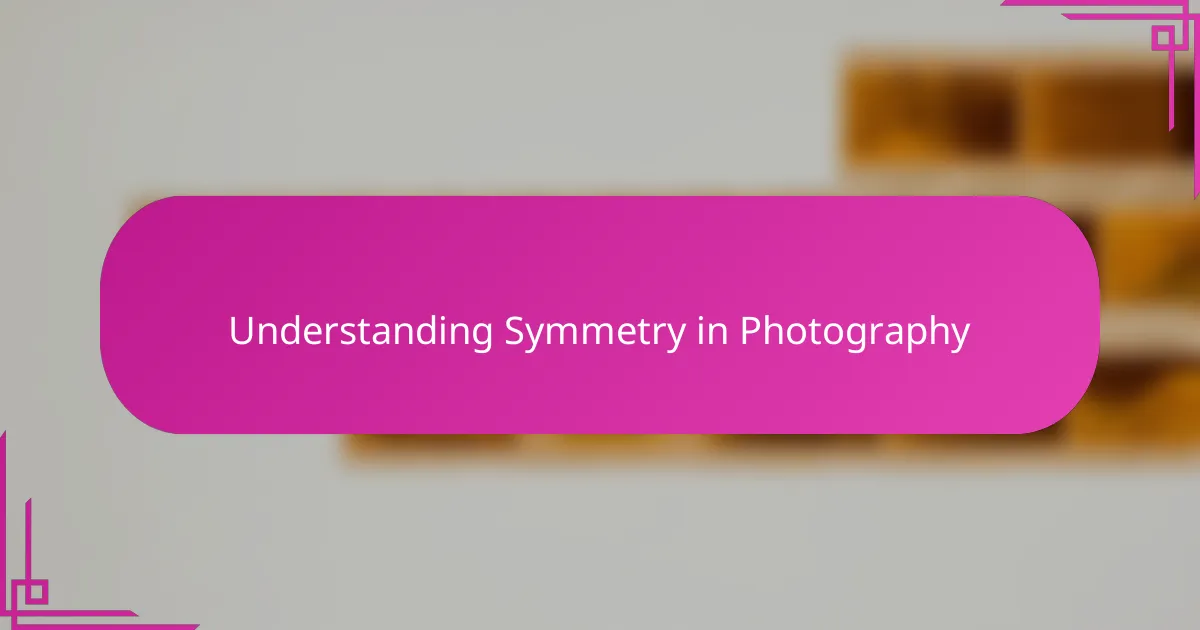
Understanding Symmetry in Photography
Symmetry in photography fascinates me because it taps into a natural sense of balance and order that our eyes instinctively crave. When I first started noticing symmetrical patterns in the urban landscape, it felt like uncovering hidden harmony amid the city’s chaos. Have you ever paused and caught yourself drawn to a perfectly mirrored scene? That moment reveals why symmetry holds such power in an image.
To me, understanding symmetry is not just about spotting identical halves but appreciating how these visual echoes create a rhythm within the frame. It’s like the city is silently speaking through shapes and lines that reflect each other, inviting me to capture a moment where everything aligns just right. This interplay of proportion and repetition gives photos a striking, almost calming presence.
Sometimes, symmetry isn’t flawless, and that’s what makes it intriguing—it challenges us to embrace imperfection while seeking balance. I’ve found that exploring these slight variations encourages me to see the urban environment through a more thoughtful and creative lens. So, how do you define symmetry in your own photography? For me, it’s a dynamic dance between equality and visual interest.
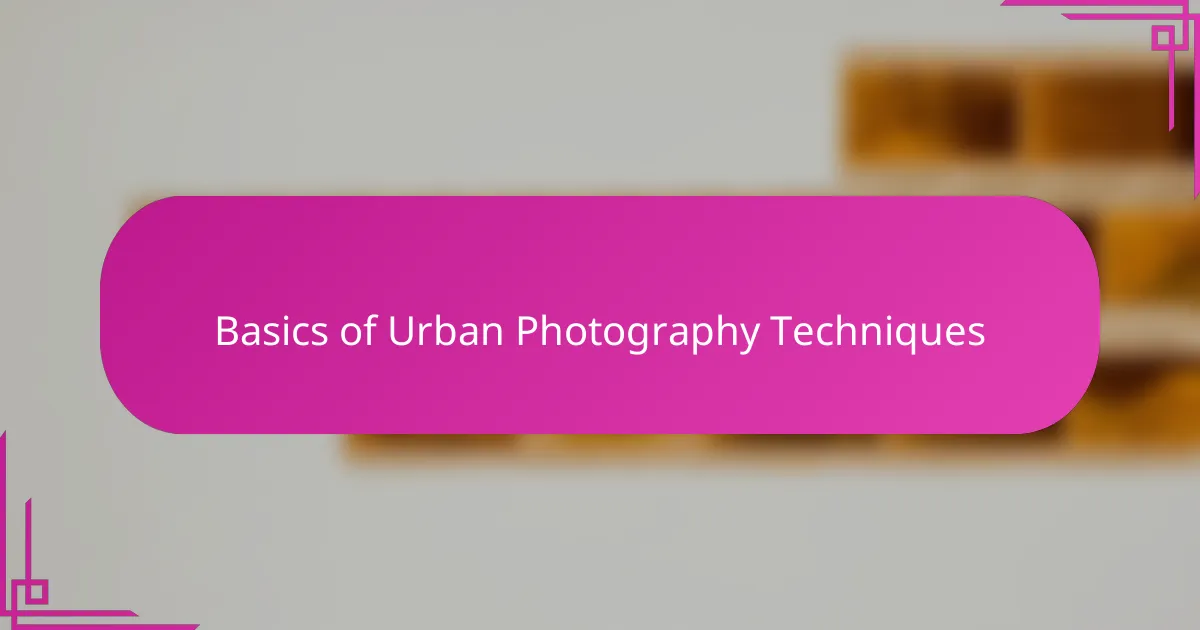
Basics of Urban Photography Techniques
Urban photography, to me, starts with really seeing the city’s geometry—the lines, angles, and shapes that form its skeleton. I remember one afternoon walking down a narrow street when I suddenly noticed how the shadows from lampposts aligned perfectly with the building edges, creating a natural frame. Have you ever experienced that sudden clarity, where everything feels structured yet spontaneous?
Mastering basic techniques like controlling light and perspective feels essential in capturing these moments. For instance, adjusting my camera’s aperture to sharpen the depth of field often lets me emphasize patterns that might otherwise go unnoticed. Do you find yourself playing with angles to reveal the unseen symmetry lurking in urban scenes?
Another fundamental I embrace is composition rules, like the rule of thirds or leading lines, as they help guide the viewer’s eye through the image. Yet, I’ve learned that sometimes bending these rules uncovers unique views, making the symmetry pop even more strikingly. It’s a balance between discipline and creativity, much like the city itself.
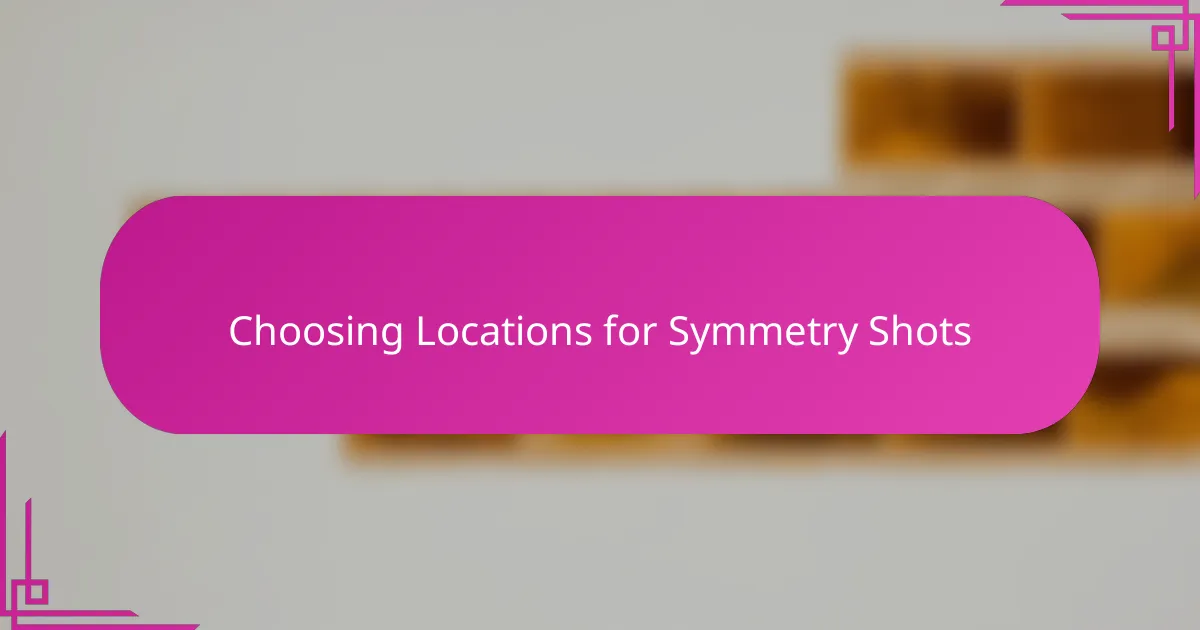
Choosing Locations for Symmetry Shots
One of the first things I do when choosing locations for symmetry shots is to scout places where architecture naturally leans toward balance—think historic buildings with repetitive windows or bridges with evenly spaced supports. Have you ever been captivated by how a row of identical street lamps or a series of balconies can create a visual rhythm? Those spots almost call out to be captured, promising symmetry that feels timeless and deliberate.
I also tend to look for places where the urban environment plays with reflection, like glass façades or puddles after rain. These reflections add a new layer to symmetry and often surprise me with unexpected angles. Sometimes, it’s not just the building itself but the way light hits and mirrors surfaces that reveal hidden mirrors in the cityscape.
Interestingly, I’ve noticed that symmetry often thrives in transitional spaces—underpasses, alleyways, or train stations—where lines converge and perspectives narrow. These places can feel a bit raw or even chaotic, yet when framed right, they transform into harmonious compositions. Do you ever find beauty in these overlooked corners? I find that’s where the most captivating symmetry often hides.

Equipment for Capturing Symmetry
When it comes to equipment for capturing symmetry, I’ve found that a sturdy tripod is absolutely indispensable. It not only helps me maintain a perfectly level horizon but also allows me to fine-tune compositions with precision—a must when balancing symmetrical elements in an urban scene. Have you ever struggled to keep your camera steady enough to line up those exact mirrored lines? A tripod makes that so much easier.
Lenses play a crucial role too. I usually reach for a wide-angle lens because it captures more of the environment, emphasizing the scale and repetition of urban patterns. But sometimes, switching to a prime lens with a fixed focal length can help isolate details and amplify the symmetry within smaller architectural features. The lens choice really shapes how the symmetry emerges in the frame.
I also rely heavily on the camera’s built-in grid or live view overlays to help align elements during shooting. It’s like having an invisible guide that nudges my eye toward perfect balance before I even press the shutter. Do you use any in-camera tools to help with alignment? Integrating these tools into my workflow has transformed how confidently I capture symmetrical scenes.
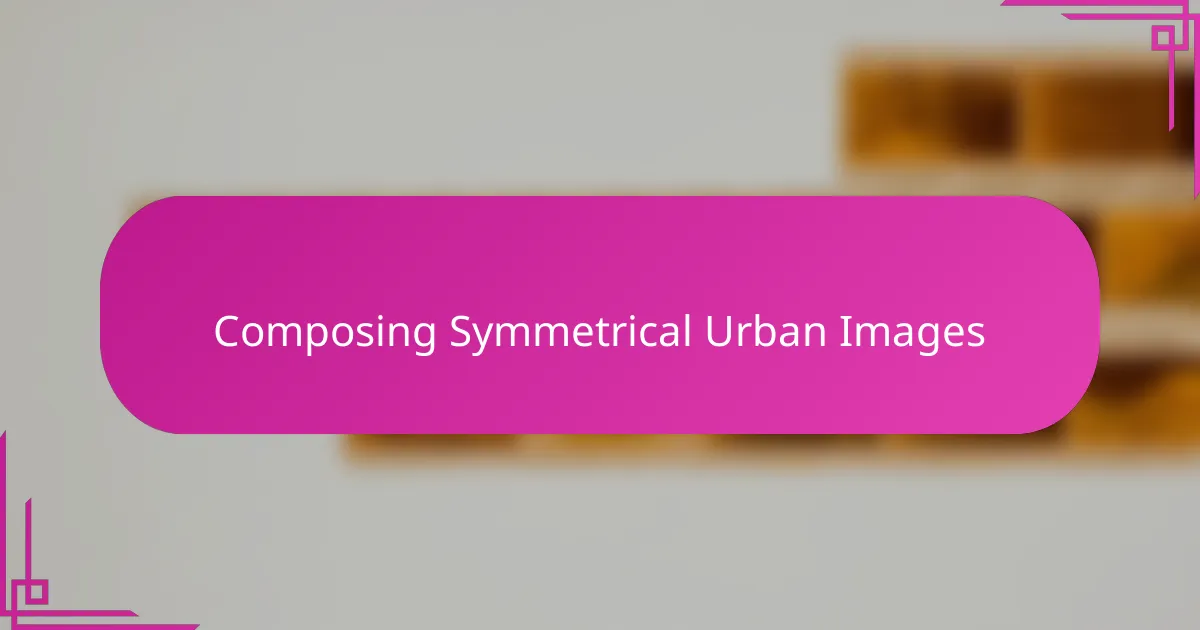
Composing Symmetrical Urban Images
Composing symmetrical urban images often feels like piecing together a puzzle where every element has its perfect place. I remember crouching low on a busy sidewalk, adjusting my angle by mere centimeters until the buildings on either side aligned flawlessly, creating a visual tunnel that both grounded and elevated the scene. Have you ever lingered over a frame, shifting your perspective just to coax out that elusive symmetry? That process of fine-tuning is as rewarding as the final shot itself.
I’ve learned that approaching composition with patience is key. Sometimes symmetry reveals itself only when you step back or take a few unpredictable twists—maybe a reflection on a rain-soaked street or the parallel shadows cast late in the afternoon. It’s those moments when the urban landscape unexpectedly mirrors itself that make me feel like I’m discovering a secret rhythm in the city’s heartbeat.
Balancing the elements within the frame also means embracing some creative freedom. Yes, placing the central axis precisely is satisfying, but I’ve found that slight deviations can add character without ruining the harmony. Have you tried experimenting with off-center symmetry to add tension? For me, these subtle breaks from perfect balance often transform a technically correct image into one full of life and intrigue.
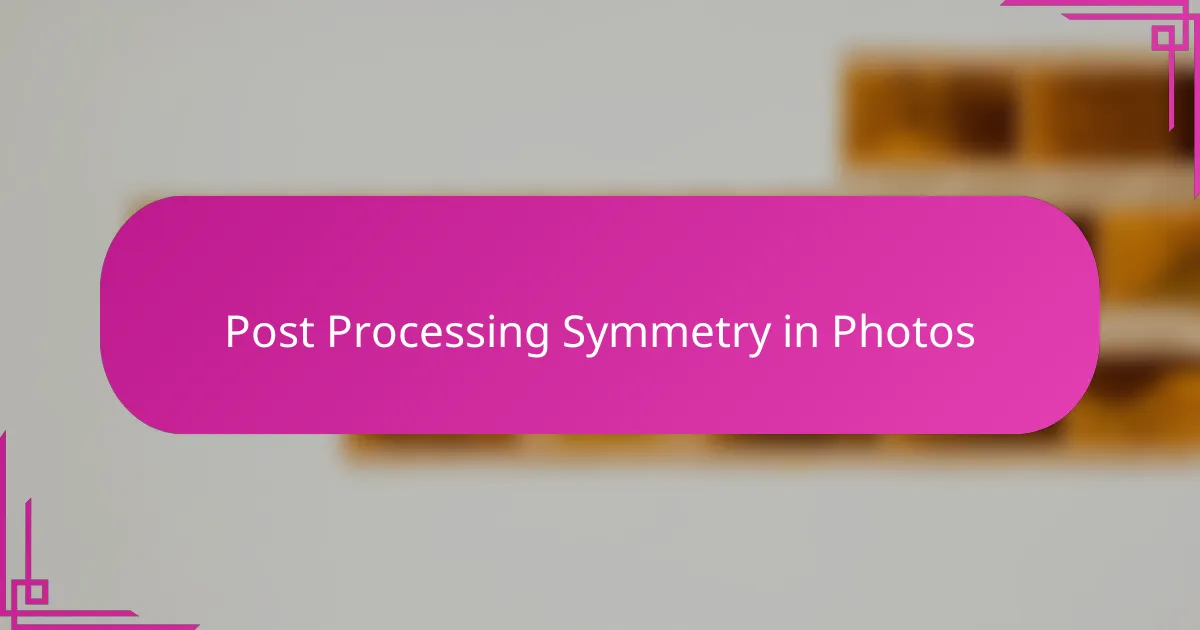
Post Processing Symmetry in Photos
When I dive into post processing, I see it as the final step to truly emphasize symmetry that might have been subtle in-camera. Sometimes, a slight crop can perfectly center the frame, turning a decent shot into something visually striking. Have you ever caught yourself adjusting just a few pixels to align edges and suddenly the whole image feels more balanced? I find that those small tweaks often unlock the photo’s full potential.
Color grading and contrast adjustments also play a huge role for me in highlighting symmetrical elements. Boosting clarity or deepening shadows can enhance repeating patterns and make lines pop, but I try to keep it natural—too much editing risks losing the authentic urban feel. Do you ever struggle with where to draw the line between enhancing symmetry and over-processing? For me, subtlety is key; the post work should feel invisible but powerful.
Occasionally, I experiment with mirroring parts of an image in editing software to create perfect symmetry where the scene didn’t naturally allow it. It’s a fun way to explore artistic interpretation, but I always weigh whether it respects the urban environment or becomes too artificial. Have you tried this technique? I think it’s a fine line between creative expression and preserving the city’s genuine character.
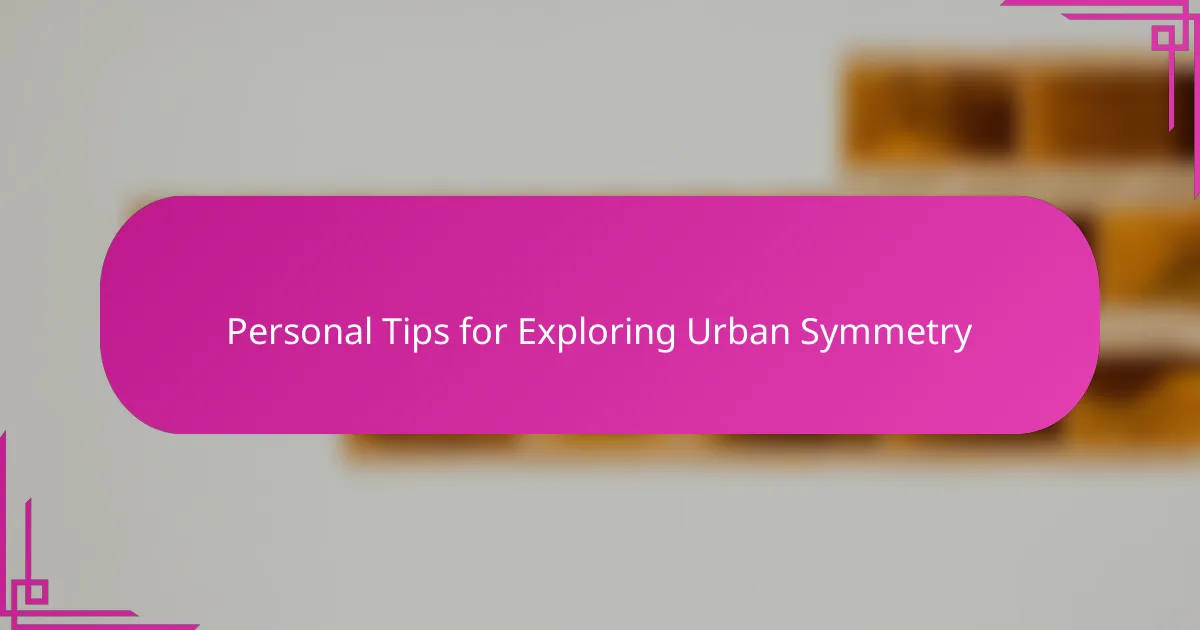
Personal Tips for Exploring Urban Symmetry
One tip I swear by is to slow down and really observe the urban environment. I remember once wandering through a quiet plaza, feeling rushed, until a sudden pause led me to see how a set of identical doors perfectly framed a narrow alley. Have you noticed how taking a moment can reveal symmetry you’d otherwise miss in the city’s hustle?
Another approach I find invaluable is experimenting with different perspectives. Kneeling low or climbing higher often transforms an ordinary street into a playground of repeated lines and shapes. It’s amazing how shifting just a few feet can turn chaos into calm balance—have you tried changing your viewpoint to unlock new symmetrical patterns?
Lastly, I embrace imperfection as part of the story. Not every symmetrical scene is flawless, and sometimes little irregularities add character and depth. Rather than chasing perfect mirroring, I look for the tension between symmetry and surprise—doesn’t that make the image feel more authentic and alive?